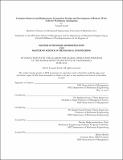Container removal and replacement automation : design and development of robotic work cells for warehouse automation
Author(s)
Aroub, Youssef.
Download1149091023-MIT.pdf (3.074Mb)
Other Contributors
Sloan School of Management.
Massachusetts Institute of Technology. Department of Mechanical Engineering.
Leaders for Global Operations Program.
Advisor
Stephen Graves and Kamal Youcef-Toumi.
Terms of use
Metadata
Show full item recordAbstract
Amazon has grown at a rapid pace. In 2018, Amazon retail sales amounted to $141.92B, up 19.7% from the previous year. The number of units shipped through its Prime program alone grew by 20% from 5 billion the previous year while third party sellers grew by 27.2%. This growth has repercussions on hiring needs and capital investments. Between 2017 and 2018, fulfillment expenses increased by 34.7% from 25.2B to 34B. In 2018, the Amazon workforce grew by 14.4% to 647,500 employees and the company added more than 8 million square feet to its fulfillment network, a 7% increase from its 2017 footprint. Significant productivity and efficiency gains are required to sustain this increase in throughput, product catalogue, supply chain complexity, and decrease in shipping lead times. The design and safe deployment of advanced technologies such as robotics is crucial in enabling future growth and creating better customer outcomes. The Inbound Cross Docks (IXDs) are a critical area for automation. At IXDs, products are received, sorted, and shipped to FCs akin to a hub-and-spoke system. A trade-off inherent to the IXD process is that it increases both the number of touches per unit and the end-to-end process time to get units on the shelves. Automation can reduce touches, lead time, and concessions while increasing throughput and labor efficiencies. This thesis proposes a robotic work cell to automate the removal of full containers from a sorting machine and the replenishment of empty containers in which products will be sorted in IXDs. Using a DMADV approach, the current process operational envelope was measured. A series of controlled experiments tested the effects of automation on process jams and outcomes, as well as methods to lower their occurrence. Concept layouts were completed from robotics physics and FlexSim operational simulations. A test robotic work cell was designed to test functionalities such as the detection and problem solving of containers, the goal being to de-risk and conclusively proof multiple functionalities in support of the full implementation. The solution proposed is a robot on rail with a single end-effector and a COGNEX vision system to check for overfull containers. If positive, containers would be routed to shaking conveyance, which has been shown to fix 77% of overfull containers. Finally, problem solving intervention would still be required to troubleshoot edge cases. A financial analysis conducted for the deployment of the proposed solution has shown a potential 3-year NPV of $18.1MM USD with a payback period of 2.12 years in 10 IXDs. From this project, a general framework for deployment of automation projects was created from interviews that could be of benefit to companies seeking to develop capabilities in warehouse automation.
Description
This electronic version was submitted by the student author. The certified thesis is available in the Institute Archives and Special Collections. Thesis: M.B.A., Massachusetts Institute of Technology, Sloan School of Management, in conjunction with the Leaders for Global Operations Program at MIT, 2019 Thesis: S.M., Massachusetts Institute of Technology, Department of Mechanical Engineering, in conjunction with the Leaders for Global Operations Program at MIT, 2019 Cataloged from student-submitted PDF version of thesis. Includes bibliographical references (pages 84-85).
Date issued
2019Department
Sloan School of Management; Massachusetts Institute of Technology. Department of Mechanical Engineering; Leaders for Global Operations ProgramPublisher
Massachusetts Institute of Technology
Keywords
Sloan School of Management., Mechanical Engineering., Leaders for Global Operations Program.